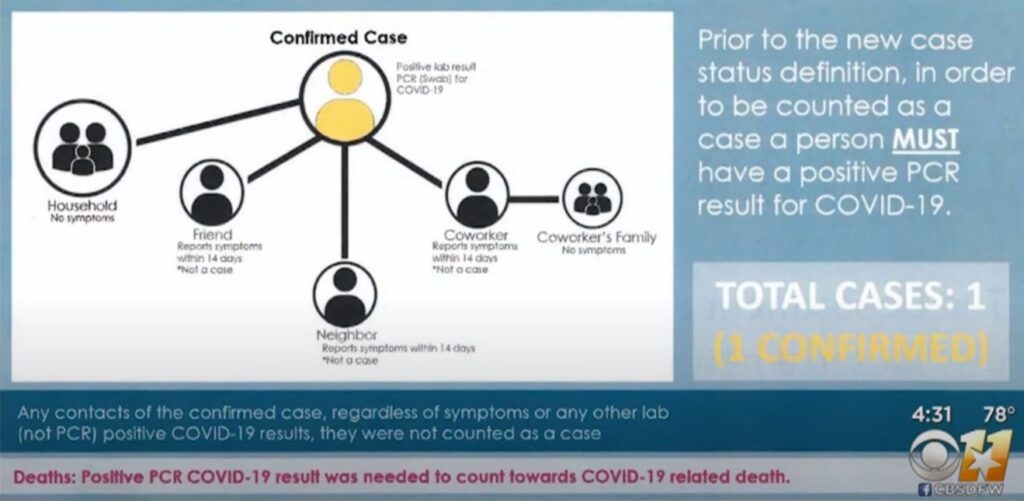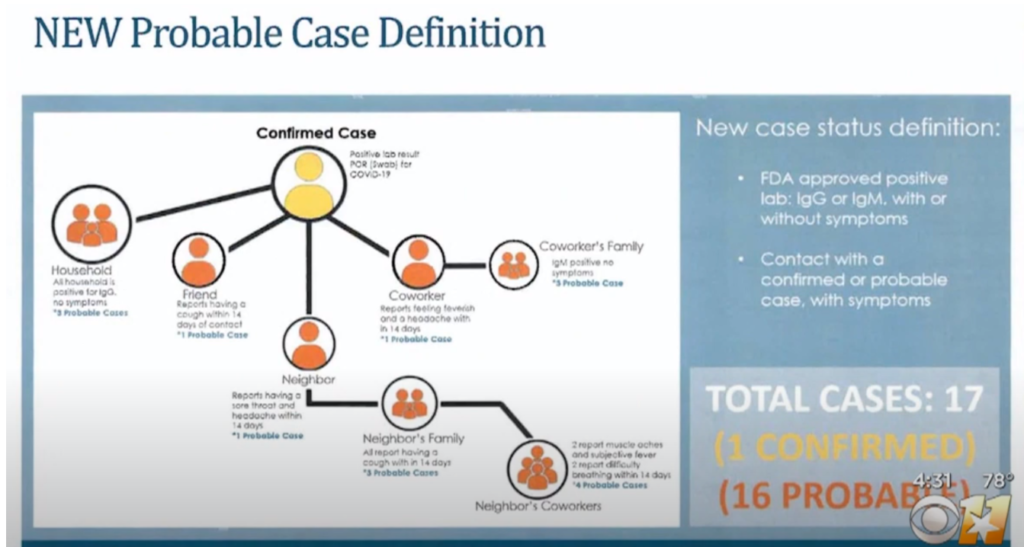Throughout the pandemic, the reported numbers of Covid-19 cases have been grossly inflated. Not only were “confirmed” cases based on inappropriate use of PCR (the nasal swab test), which was never intended to diagnose infection, but early in 2020, the CDC guidelines for counting cases were actually changed to include “probable cases,” for which an extremely loose definition was created.
Multiple videos of a meeting of county commissioners in Collin County, Texas, in which the newly adopted CDC guidelines for case counting are clearly spelled out, have been removed from YouTube, so finding them is a challenge. However, the following visual aids used at that meeting by the Collin County Epidemiology Department spokesperson to explain the new counting methods highlight the problem very effectively. Everything in the visual presentation is based on the CDC’s Interim Case Definition from April 5th, 2020.
Before April 2020, one person with a “positive” PCR test would have been counted as a single case. Friends, neighbors, and coworkers would not have been counted as cases, even if they had symptoms of illness, without a positive PCR test.

But by using the CDC’s “revised case definition,” adopted April 5th, 2020, a single case of Covid-19 (determined through the use of PCR) could, as we see in this example, be recorded as 17 cases – one confirmed case and 16 “probable” cases – all of which would be included in official case counts:

In that second illustration, the 16 “probable” cases include the person’s family members, friends, neighbors, coworkers, and even coworkers of neighbors – none of whom are tested specifically for Covid-19, and some of whom have no symptoms at all. Even a coworker’s family are all counted, even though they are symptom-free, because they tested positive on an IgG/IgM (antibody) test – a test which cannot distinguish between a current infection and a previous infection from months earlier (see Extras below).
The CDC also clarifies that antibody (IgG/IgM) tests cannot reliably distinguish between SARS-CoV-2 and viruses that cause the common cold and notes that “serologic test results do not indicate with certainty the presence or absence of current or previous infection with SARS-CoV-2.”
The epidemiology department spokesperson stated clearly that these “probable” cases were to be included in the official case count totals, and this is also explicitly stated on the CDC’s website: “As of April 14, 2020, CDC case counts and death counts include both confirmed and probable cases and deaths.”
Obviously, some Collin County leaders feared that inflating the numbers to include “probable” cases in official totals would be interpreted by the public as an increase in Covid-19 illness. This news report highlights Commissioner Darrell Hale’s concerns about implementing the new case definition just as Texas was beginning to allow businesses to reopen:
As Commissioner Hale put it:
“I don’t want there to be any fear manifesting as we start to open back up… If you reside in Texas and you have two minor symptoms, you could actually have a Covid probable case definition assigned to you, and then you’re supposed to stay in your house for 14 days and be quarantined.”
And sure enough, the media portrayed the increase in case numbers as an increase in actual illness, as illustrated in this BBC news segment about the case “surge” in Texas. The report makes absolutely no mention of the new case counting scheme but promotes the notion that there was a “spike” in Texas cases, laying the blame for this supposed spike on the reopening of businesses, just as Commissioner Hale predicted, and leading the public to believe that opening businesses had increased the spread of sickness from Covid-19:
As previously noted, these changes are all based on CDC guidelines (adopted from the Council for State and Territorial Epidemiologists) and were issued to all states. The CDC eventually advised states to separate “probable” from “lab-confirmed” cases, but as of June 2020, “[a]ccording to the CDC’s COVID data tracker, only 24 states [had taken] the agency’s advice” to separate their data.
An obvious problem with grouping people who have symptoms common to both Covid-19 and seasonal flu together in the Covid-19 case counts is that people who actually do have the flu will be miscategorized as Covid-19 cases instead of flu cases. And, in fact, flu diagnoses have declined dramatically – by about 95%. Incredibly, however, instead of explaining that flu cases have simply been misclassified by using the new, “revised” case definitions, media outlets are actually reporting that the flu has somehow been all but eradicated. Here is how the UK’s Sunday Times reported the supposed drop in flu cases:
“The number of people suffering from flu has plunged by 95% to levels not seen in more than 130 years, according to experts and official data. Influenza has been ‘almost completely wiped out’, said Simon de Lusignan, professor of primary care at the University of Oxford and director of the Royal College of GPs research and surveillance centre, which focuses on flu. ‘I cannot think of a year this has happened.’
“In the second week of January, usually the peak of the season, the number of influenza-like illnesses reported to GPs was 1.1 per 100,000 people, compared to a five-year average rate of 27.”
And here is an excerpt from a Yahoo! news article:
“John McCauley, director of the World Health Organisation’s collaborating centre for reference and research on influenza, told the newspaper [the UK’s Sunday Times]: ‘The last time we had evidence of such low rates was when we were still just counting influenza deaths, and that was in 1888, before the 1889-90 flu pandemic.’
“Experts told the newspaper that the coronavirus pandemic could have contributed to plummeting levels of flu cases with improved hygiene and measures taken to combat the COVID crisis helping limit the spread of flu.”
These experts are literally proposing that while unprecedented safety measures imposed all over the world haven’t stopped Covid-19 numbers from allegedly skyrocketing, those same measures have somehow been enormously effective at preventing the flu, driving cases down to a mere 5% of the expected number. In fact, while some epidemiologists are striving to call attention to the misleading practice of classifying flu cases as Covid-19 cases, UK health authorities, for instance, are currently claiming that the UK has not seen a single case of flu so far in 2021.
The bottom line: “case counts” for Covid-19 have been wildly exaggerated and often have absolutely nothing to do with actual illness at all. The numbers are meaningless.
____________________
Extras:
Dr. David Persse, Chief Medical Officer for Houston, Texas (April 8, 2020) explains that the antibody test detects evidence of all coronaviruses, including the common cold, not specifically COVID-19 (2-minute explanation begins at 23:30; or go to 19:18 to hear full question in context):
Dr. Persse assures the council that Texas hospitals have “quite a bit of capacity” for potential surge (26:20) and that it is normal for hospitals to be near 100% capacity during any flu season (26:37):
“The Crisis of Science” – excellent report by James Corbett detailing conflicts of interest, consensus-promoting funding incentives, and peer-review fraud among scientists. Interestingly, YouTube has removed this video, but it can be seen at TheCorbettReport.com.
Links, transcripts, and audio here: https://www.corbettreport.com/sciencecrisis/